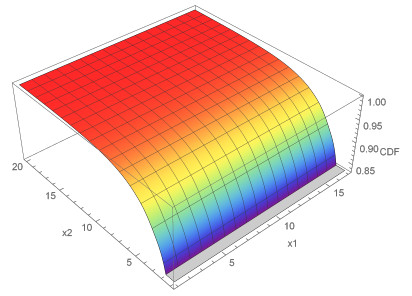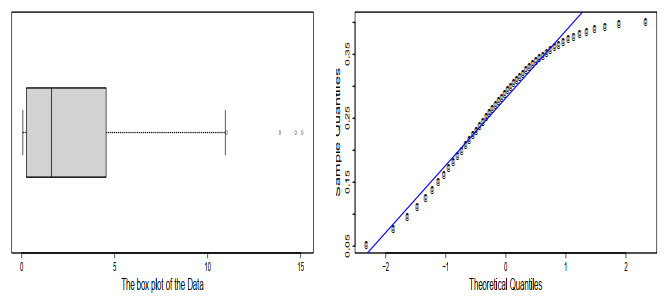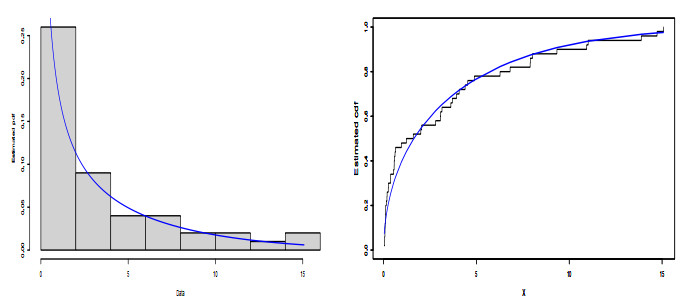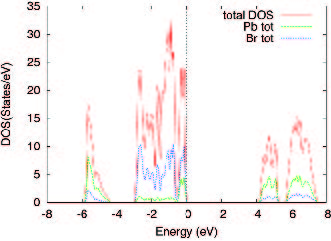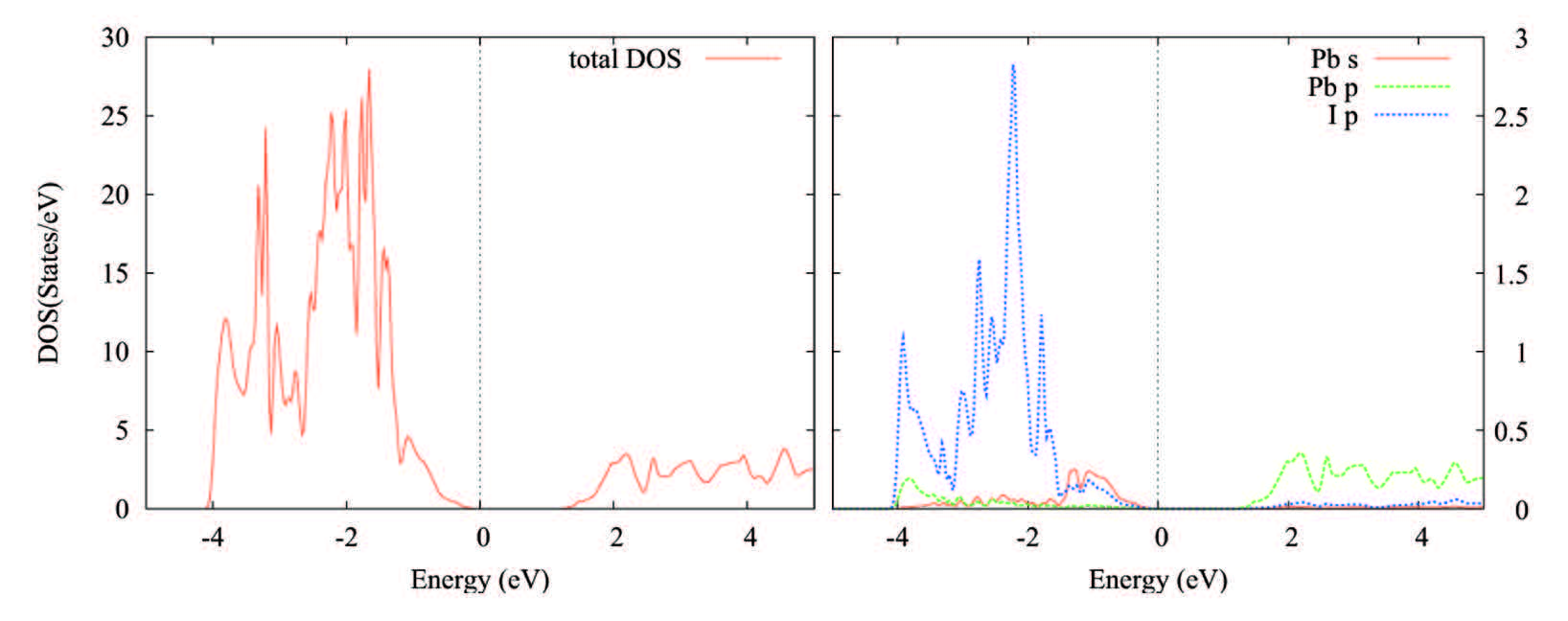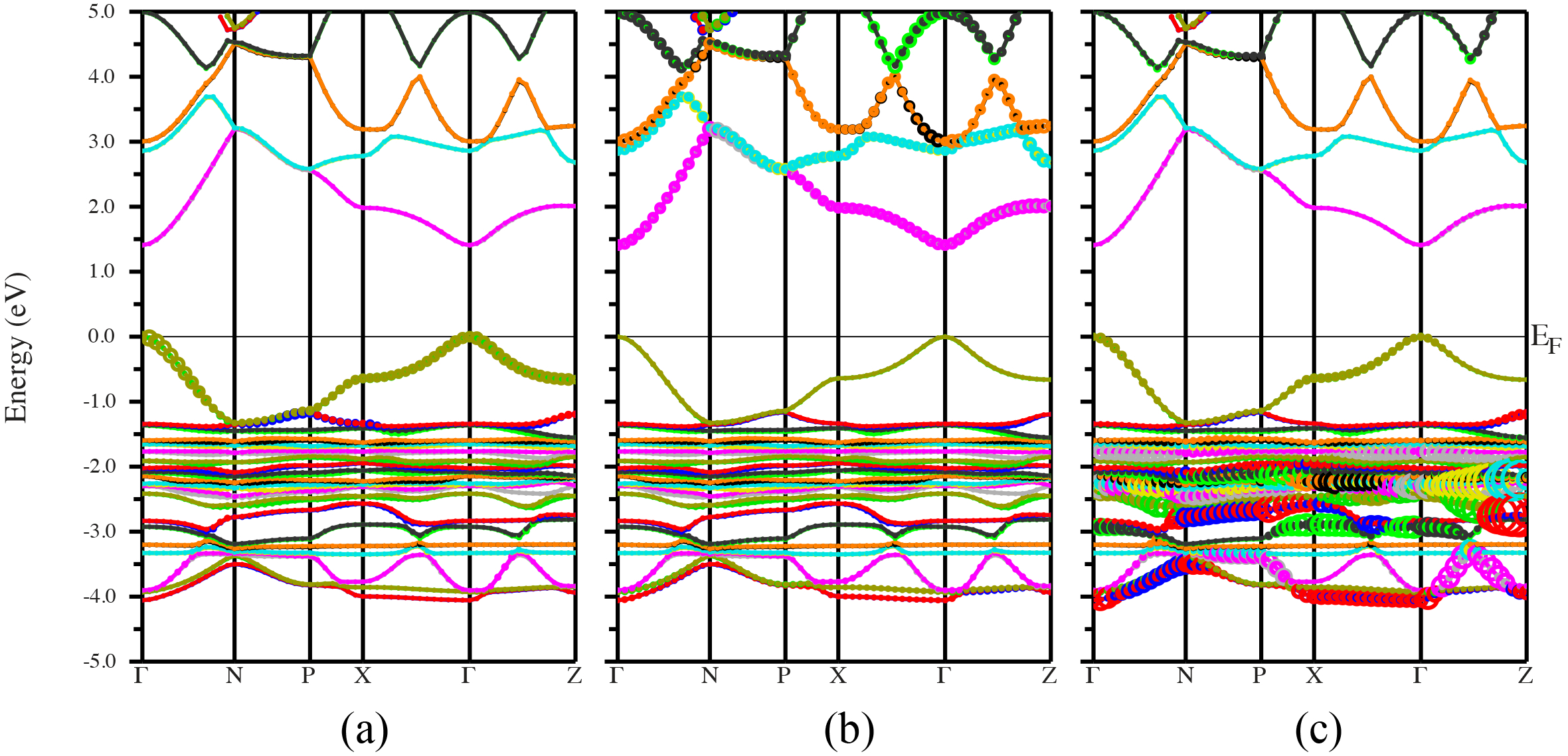We report first-principles calculations, within density functional theory, on the lead halide compounds PbCl2, PbBr2, and CH3NH3PbBr3−xClx, taking into account spin-orbit coupling. We show that, when the modified Becke-Johnson exchange potential is used with a suitable choice of defining parameters, excellent agreement between calculations and experiment is obtained. The computational model is then used to study the effect of replacing the methylammonium cation in CH3NH3PbI3 and CH3NH3PbBr3 with either N2H5+or N2H3+, which have slightly smaller ionic radii than methylammonium. We predict that a considerable downshift in the values of the band gaps occurs with this replacement. The resulting compounds would extend optical absorption down to the near-infrared region, creating excellent light harvesters for solar cells.
1.
Introduction
There are many phenomena in this world that need statistical description to be more understandable to the reader, but there is no specific statistical distribution that describes all of them. Therefore, many researchers have recently tried to develop new families by adding one, two or three parameters, e.g., [1,2,3,4,5]. By adding two additional parameters $ \beta $ and $ \gamma $, Cordeiro et al. [6] introduced the generalized Weibull distribution family. We continue this line of research by proposing a novel family, namely, a generalized Weibull-modified Weibull model. A model was developed that can fit real data because the model has great flexibility in representing nonlinear dynamics. The model is useful for studying data science through statistical modeling and it has been applied to engineering data. Its application in engineering shows that the developed model is adaptable and flexible in terms of ability to represent complex data. For any cumulative function (CDF) $ W(x) $ and probability density function (PDF) $ w(x) $, the CDF and the PDF of the proposed family are respectively given by
and
Type-Ⅰ and Type-Ⅱ-censorship schemes are the two most common and popular censorship schemes. Type-Ⅰ and type-Ⅱ censorship schemes were merged by Epstein [7] in the hybrid censorship scheme. For a more brief review of censoring schemes, we refer the reader to [8–14]. Balakrishnan et al. [15] have proposed a unified hybrid censoring method. Huang and Yang [16] have considered a combined hybrid censoring sample. Emam and Sultan [17] combined the unified hybrid censoring sampling method and the combined hybrid censoring sampling method into a unified approach known as C-UHCS$ (m, r; T_{1}, T_{2}) $, which refers to the combined-unified hybrid censoring method. The likelihood function of C-UHCS$ (k, r; T_1, T_2) $ is
where $ k $ and $ T $ can be chosen as:
Then, for a parameter space $ \Omega $, the likelihood function of C-UHCS$ (m, r; T_1, T_2) $, which represents all possible likelihood functions under different values of $ k $, $ T $, and $ {\textbf{x}}_{k} = (x_{1}, x_{2}, ..., x_{k}) $, can be written as
The authors believe that this problem deserves investigation. The main motivations for using the GMW-X family in practice are as follows: 1) It is an excellent way to enter additional parameters to create an extended version of the basic model. 2) It can improve the properties of the traditional distributions. 3) It can create symmetric, right-skewed and left-skewed distributions. 4) It can provide a consistently better fit than other models. This was a good incentive to study the problem, and this was supported by the numerical results, which confirmed the superiority of the new model over many of the basic and competing models.
The rest of this work is presented here as follows. The generalized Weibull-modified Weibull distribution (GWMWD) is presented in Section 2. The bivariate extension of the generalized Weibull-modified Weibull model is discussed in Section 3. Based on C-UHCS$ (m, r; T_{1}, T_{2}) $, Section 4 is devoted to applying the maximum likelihood approach to the GWMWD. Section 5 presents the Monte Carlo procedure. Section 6 applies the GWMWD to a data set of 50 electronic component failures. Section 7 shows some conclusions.
2.
Generalized Weibull-modified Weibull model
Let X be a random variable (R.V.) with the modified Weibull distribution $ (\omega, \theta, \nu) $ distribution suggested by Sarhan and Zaindin [18]; then, its CDF is
and its PDF is given by
where $ \omega\geq 0 $ is a scale parameter, while $ \delta\geq 0 $ and $ \nu > 0 $ are shape parameters such that $ \nu+\delta > 0 $.
The generalized Weibull distribution family generalizes the generalized Weibull normal distribution when $ \beta = \gamma = 1 $, the generalized Weibull Gumbel distribution when the generalized Weibull family $ \beta\gamma = 1 $, and the generalized Weibull logistic distribution. The GWMWD is defined from (1.1) by replacing $ W(x) $ and $ w(x) $ with $ W(x; \omega, \delta, \nu) $ and $ w(x; \omega, \delta, \nu) $, respectively. The CDF and PDF of GWMWD, respectively, are
and
The survival function (SF) and hazard rate function (HRF) via the GWMWD of time $ t $, respectively, are
and
In particular, the GWMWD generalizes the generalized Weibull-Weibull distribution (when $ \omega = 0 $), the generalized Weibull-Rayleigh distribution (when $ \omega = 0 $ and $ \nu = 2 $), the generalized linear Weibull exponential distribution (when $ \nu = 2 $ and $ \delta = \omega/2 $, $ \omega > 0 $), and the generalized Weibull exponential distribution (for $ \nu = 0 $). In what follows, an R.V. X with the GWMWD PDF (2.3) is written as $ X \sim GWMWD(\beta, \gamma, \omega, \delta, \nu) $.
Some possible behaviors of the CDF, PDF, and HRF for GWMWD $ (\beta, \gamma, \omega, \delta, \nu) $ are shown in Figure 1. The left panel shows GWMWD (10.2, 10.9, 0.50, 12.9, 4.20), GWMWD(0.20, 0.90, 0.50, 1.90, 0.20), GWMWD (10.20, 6.90, 0.50, 1.90, 0.20), GWMWD (1.20, 3.90, 0.65, 0.90, 0.20), and GWMWD (0.20, 12.9, 0.30, 1.10, 0.01), while the right panel shows GWMWD (10.2, 10.9, 0.50, 12.9, 4.20), GWMWD (7.20, 8.90, 1.50, 12.9, 4.20), GWMWD (8.20, 7.90, 3.90, 10.9, 3.50), GWMWD (8.20, 6.90, 7.50, 12.9, 4.20), and GWMWD (1.20, 9.90, 2.50, 12.9, 4.20). From Figure 1, it can be seen that the CDF increases faster with increasing x for the parameters $ \beta $ and $ \delta > 1 $; then, it is constant and the graph grows exponentially, the PDF increases faster with increasing x for the parameters $ \beta $ and $ \delta > 1 $, and the proposed GWMWD has strong spurs; the HRF is constant and then increases faster with increasing x when the parameters $ \beta, \gamma, \delta $ and $ \alpha > 1 $. The PDF shape is at times very flexible. It appears to approximate a bell curve with some twist. At other times it appears to have strong tails. Because of the divergent behavior of the proposed model, it could be a good candidate for modeling semi-normal and strong-tailed data in various industrial, financial, and medical applications.
3.
Bivariate GWMWD
The copula model was introduced by Morgenstern [19] to represent the joint CDF of the two marginal univariate distributions. Let $ \digamma\left(x_{j} \right) $ be the CDF of $ X_{j}, j = 1, 2 $. Conway [20] introduced the joint CDF and PDF of the copula model, respectively, as
and
where $ \rho $ is the dependence measure between $ X_{1} $ and $ X_{2} $. Let the R.V.s $ X_1 \sim $ GWMWD $ (\beta_1, \gamma_1, \omega_1, \delta_1, \nu_1) $ and $ X_2 \sim $ GWMWD $ (\beta_2, \gamma_2, \omega_2, \delta_2, \nu_2) $; then, the corresponding joint CDF and PDF are, respectively, given by
and
Figure 2 presents the CDF for the bivariate GWMWD (0.1, 0.8, 4.4, 6.1, 3.20) and GWMWD (0.1, 0.8, 4.4, 6.1, 0.20) when the parameter $ \nu $ increases, and for $ \rho = 0.2 $.
The copula function is a way to construct bivariate distributions. Other methods can be reviewed and may be helpful to introduce some new bivariate distributions (see, Xu et al. [21] and Luo et al.[22].)
4.
Likelihood function under C-UHCS
Suppose that $ \{x_{1}, x_{2}, ..., x_{k}\} $ is an observed sample from $ X \sim GWMWD (\beta, \gamma, \omega, \delta, \nu) $. The likelihood function of $ \beta, \gamma, \omega, \delta, $ and $ \nu $ becomes
and the log-likelihood function $ (L) $ is
Let $ Q(x) = \omega x+\delta x^{\nu} $. The first partial derivatives of (4.2) with respect to $ \beta, \gamma, \omega, \delta $ and $ \nu $ are given by
The maximum likelihood estimators $ \hat{\beta}_{ML}, \hat{\gamma}_{ML}, \hat{\omega}_{ML}, \hat{\delta}_{ML}, $ and $ \hat{\nu}_{ML} $ of the GWMWD $ (\beta, \gamma, \omega, \delta, \nu) $ parameters are the solutions of (4.3)–(4.7). The asymptotic confidence intervals of the parameters $ \beta, \gamma, \omega, \delta $ and $ \nu $ can be calculated. $ \hat{V} = V(\hat{\beta}_{ML}, \hat{\gamma}_{ML}, \hat{\omega}_{ML}, \hat{\delta}_{ML}, \hat{\nu}_{ML}) $ is the observed variance covariance matrix, such that
where
An approximate $ 100(1-\epsilon)\% $ two-sided C.Is for the parameters $ \beta, \gamma, \omega, \delta $ and $ \nu $ are
and
respectively, where the diagonal elements of $ \hat{V} $ $ V(\hat{\beta }), $ $ V(\hat{\gamma }), $ $ V(\hat{\omega }), $ $ V(\hat{\delta }), $ and $ V(\hat{\nu }) $ are the estimated variances of $ \hat{\beta }_{ML}, ˆγML,
\hat{\omega }_{ML}, $$ \hat{\delta }_{ML}, $ and $ \hat{\nu }_{ML}, $ and $ z_{\epsilon /2} $ is the upper $ \left(\frac{\epsilon}{2}\right) $ percentile of the normal(0, 1) distribution.
5.
Monte Carlo simulation study
Let U have a uniform (0, 1) distribution. The GWMWD can be simulated by using the solution of the nonlinear equation
We simulate the GWMWD for two sets of the parameters: Set 1: $ \beta = 1.4, \gamma = 3.0, \omega = 0.7, \delta = 1.3, \nu = 0.4 $, and Set 2: $ \beta = 0.4, \gamma = 1.0, \omega = 1.7, \delta = 1.5, \nu = 1.8 $. The empirical results of the Monte Carlo simulation study are given in Table 1 for Set 1. The empirical results of the Monte Carlo simulation study are given in Table 2 for Set 2. Suppose that the data were observed for the GWMWD under the censoring scheme C-UHCS$ (m, r; T_{1}, T_{2}) $ and set the arbitrary values for termination as $ T = X_{k} $ and $ k = \frac{4}{5} n $. The simulation study is carried out as follows
1) Random samples of size $ n = 25, 50, ..., 1000 $ were simulated from the GWMWD.
2) The model parameters were estimated via the maximum likelihood method.
3) 1000 iterations were made to obtain the MLEs, biases and MSEs of these estimators.
4) Let $ \hat{\vartheta} $ be the MLE of $ \vartheta = (\beta, \gamma, \omega, \delta, \nu) $. The MLEs, biases and MSEs are given, respectively, by
and
5) The $ 90\% $ and $ 95\% $ approximate confidence intervals with their width were calculated.
6.
Reliability engineering application of the GWMWD model
This section is devoted for illustrating the GWMWD through the analysis of a reliability engineering application. The data set represents the failure times of 50 electronic components (per 1000 h); see Aryal and Elbatal [23]. Suppose that the data was observed from GWMWD under the censoring scheme C-UHCS$ (m, r; T_{1}, T_{2}) $, and set the arbitrary values for termination $ k = 45 $ and $ T = 10.943 $. Table 3 shows a summary of the reliability engineering data. The boxplot and Q-Q plot for the reliability engineering data are shown in Figure 4. The estimated parameters are $ \hat{\beta} = 0.058, \hat{\gamma} = 9.986, \hat{\omega} = 0.005, \hat{\delta} = 1.239 $, and $ \hat{\nu} = 0.056 $. Plots of the fitted density and distribution functions of the GWMWD model are shown in Figure 5. The likelihood probability (PP) and Kaplan-Meier survival curve are shown in Figure 6.
Table 4 compares the GWMWD based on some detection criteria, such as the Akaike information criterion (AIC), Bayesian information criterion (BIC), Hannan-Quinn information criterion (HQIC) and consistent Akaike information criterion (CAIC). The goodness-of-fit results of the GWMWD model are compared with some other models, including the generalized Weibull distribution (GWWD), the generalized Weibull-Rayleigh distribution (GWRD), the generalized linear Weibull exponential distribution (GLWEXPD) and the generalized Weibull exponential distribution (GWEXPD). Table 5 compares the GWMWD with the Kolmogorov-Smirnov test for one sample. The results in Tables 4 and 5 suggest that the GWMWD provides a better fit than other competing models and could be chosen as a suitable model for analyzing heavy-tailed electronic data.
7.
Conclusions
A new extension of the Weibull distribution i.e., the generalized modified Weibull distribution with five parameters, is presented. The model has a high degree of flexibility to fit the data appropriately. The provided model exhibits strong tail-heavy behavior and has unimodal increasing failure rate functions. Based on a combined-unified hybrid sample, the maximum likelihood estimators of the intended model parameters and a Monte Carlo simulation study were obtained. To illustrate the applicability and potential of the intended distribution, a dataset of failure times of 50 electronic components was analyzed. The mean square errors and biases decrease with increasing sample size. It is clear that the proposed model agrees well with the estimated PDF and CDF plots. The boxplot shows that the electronic downtime data set has a highly right skewed tail. The new generalized modified Weibull distribution based on the one-sample Kolmogorov-Smirnov test provides a better fit than other competing models. The proposed model fits the Kaplan-Meier survival plot very well. The results indicate that the generalized Weibull distribution (modified Weibull distribution) is considered ideal for modeling the intended engineering data. For future studies, we hope to discuss the accelerated life testing based on the new distribution by using stress-strength models (Zhang et al. [24,25]).
Acknowledgments
The study was funded by Princess Nourah bint Abdulrahman University Researchers Supporting Project number (PNURSP2023R226), Princess Nourah bint Abdulrahman University, Riyadh, Saudi Arabia.
Conflict of interest
The authors declare that they have no conflicts of interest.
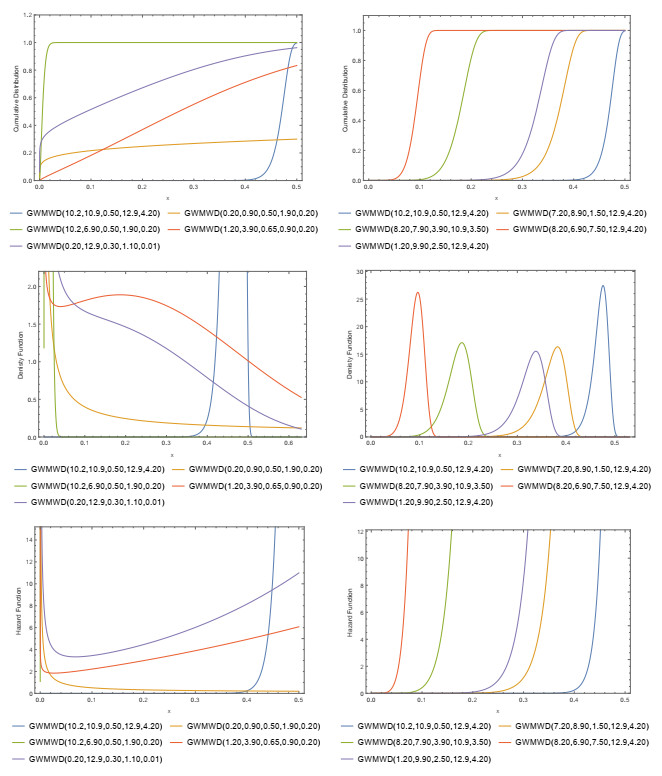









 DownLoad:
DownLoad:
